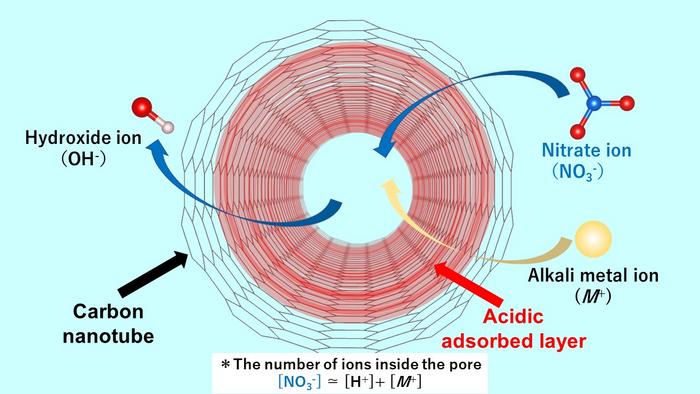To preserve life on earth, there need to be efficient purification methods that can separate impurities from water and air. Therefore, for a long time, carbon materials have been used for deodorizing, separating, and eliminating unsafe anion contaminations by adsorption.
 Acidic adsorbed layer enhances nanoconfinement of nitrate anion impurities in single-walled carbon nanotubes (SWCNT) owing to strong confinement by the pore and strong interaction between the layer and the anion. When the nitrate ions are adsorbed, the hydroxide ions are desorbed from the nanospace. Thus, the aqueous solution exhibits alkaline properties. Image Credit: Takahiro Ohkubo from Okayama University Department of Chemistry, Graduate School of Natural Science and Technology, Okayama University.
Acidic adsorbed layer enhances nanoconfinement of nitrate anion impurities in single-walled carbon nanotubes (SWCNT) owing to strong confinement by the pore and strong interaction between the layer and the anion. When the nitrate ions are adsorbed, the hydroxide ions are desorbed from the nanospace. Thus, the aqueous solution exhibits alkaline properties. Image Credit: Takahiro Ohkubo from Okayama University Department of Chemistry, Graduate School of Natural Science and Technology, Okayama University.
Thus far, the complete mechanism underlying how carbon purifies water has stayed a mystery. Furthermore, it is not established if the aqueous solution adsorbed on the carbon material is alkaline, acidic, or neutral.
To resolve these gaps, scientists guided by Dr. Takahiro Ohkubo, Associate Professor in the Department of Chemistry, Faculty of Natural Science and Technology, Okayama University, Japan, examined the central mechanism by which carbon nanopores adsorb anions.
The scientists mention how they used Raman spectroscopic tools to analyze the adsorption of nitrate ions by the cylindrical pore of single-walled carbon nanotubes (SWCNT).
Details of the research were first made available online on September 16th, 2022, and then published in the Journal of Colloid and Interface Science (volume 629 Part B).
Dr. Ohkubo and his contemporaries successfully decoded the mechanism of acidic layer creation near the pore walls. It so happened that when an aqueous solution comprising ions enters the carbon material, even if the aqueous solution is neutral, an acidic aqueous layer comprising protons is created that preserves a stable state.
To date, there have been no reports demonstrating the existence of acidic adsorption layers formed within nanotubes of carbon materials.
Dr Takahiro Ohkubo, Associate Professor, Department of Chemistry, Faculty of Natural Science and Technology, Okayama University
Dr. Nobuyuki Takeyasu, part of the research team and Associate Professor in the same faculty at Okayama University discovered that the acidic layer enables excellent adsorption of the negatively charged nitrate anion contaminations, where the adsorbed quantity of nitrate ions is a lot larger than that of the cations, or the positively charged groups.
Furthermore, hydroxide ions are produced as counter-ions. The anions in the bulk solution are swapped with the hydroxide ions in the SWCNT, rendering the aqueous solution alkaline.
The researchers analyzed anion adsorption using numerous alkali metal nitrates, including rubidium nitrate, lithium nitrate, sodium nitrate, and cesium nitrate solutions. They learned that in comparison to metal ions, more nitrate ions are adsorbed. The amount of proton adsorption was nearly the same irrespective of the kind of alkali metal ion utilized.
The acidic layer in the pore can strongly adsorb the nitrate anion species because of both strong confinement by the pore and the strong interaction between the layer and the anion.
Dr Takahiro Ohkubo, Associate Professor, Department of Chemistry, Faculty of Natural Science and Technology, Okayama University
The discoveries are crucial steps toward engineering and developing carbon nanotubes ideal for ion adsorption and decontamination of air and water. The purification mechanism formulated in this study is a unique model that elucidates the alkalinity of the aqueous solution medium, which has, up until now, been a mystery.
The scientists note that the outcomes of their study powerfully point to the need to neutralize water before use when carbon materials capture ionic impurities.
Another significant contribution of this research is the illustration that the nanomaterial interface is a unique chemical reaction field, which could direct further experiments. Based on the positive contributions, this study takes to the next level one’s understanding of the mechanism of anion adsorption by carbon, paving the way for unique carbon nanotubes as effective purifiers.
Journal Reference:
Ohkubo, T., et al. (2022) Acidic layer-enhanced nanoconfinement of anions in cylindrical pore of single-walled carbon nanotube. Journal of Colloid and Interface Science. doi.org/10.1016/j.jcis.2022.09.070.